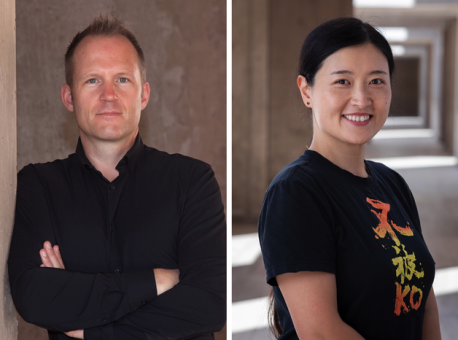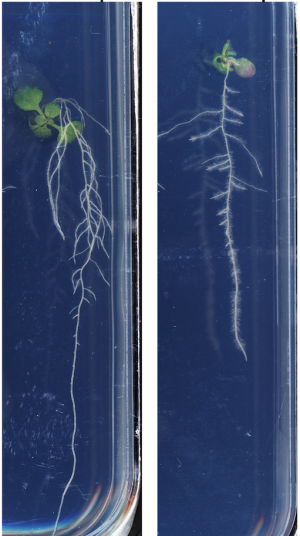
February 14, 2024
Salk scientists find highly conserved ethylene signaling pathway can be targeted to control the direction of root growth, in turn creating deeper root systems that hold on to carbon and remove carbon dioxide from the atmosphere
Salk scientists find highly conserved ethylene signaling pathway can be targeted to control the direction of root growth, in turn creating deeper root systems that hold on to carbon and remove carbon dioxide from the atmosphere
LA JOLLA—Above ground, plants stretch toward the sun. Below ground, plants tunnel through the earth. As roots soak up water and nutrients from surrounding soil, they grow and stretch to develop distinct root system architectures. The root system architecture determines whether roots remain in the shallow soil layers or grow steeper and reach deeper soil layers. Root systems are central to plant survival and productivity, determining the plant’s access to nutrients and water and, therefore, the plant’s ability to withstand nutrient depletion and extreme weather like drought.

Now, Salk scientists have determined how a well-known plant hormone is crucial in controlling the angle at which roots grow. The study, published in Cell Reports on February 13, 2024, is the first time the hormone, called ethylene, has been shown to be involved in regulating lateral root angles that shape root systems—making the findings a revelation for plant scientists optimizing root systems.
Researchers in Salk’s Harnessing Plants Initiative now plan to target the ethylene signaling pathway in their efforts to engineer plants and crops that can withstand the environmental stresses of climate change and drought, as well as remove carbon dioxide from the atmosphere and store it deep underground to help mitigate climate change.

“Deep roots lead to more durable carbon storage in the soil and can make plants more resistant to drought, so the ability to control how deep roots grow is really exciting for scientists looking to engineer better root systems,” says senior author Wolfgang Busch, professor, executive director of the Harnessing Plants Initiative, and Hess Chair in Plant Science at Salk. “We’re especially excited that the pathway we found is conserved across many types of plants, meaning our findings can be widely applied to optimize root architecture in all land plants, including food, feed, and fuel crops.”
Environmental factors—like average rainfall or abundance of certain nutrients—can influence the shape of a plant’s root system. The angle at which roots grow produces different results in overall root architecture, with horizontal root angles creating a shallower root system and vertical root angles creating a deeper root system. But scientists did not understand clearly how these root angles were being determined on a molecular level.
Plant hormones like auxin and cytokinin have been connected to the angle of root growth in the past, but the mechanisms of that connection have remained poorly understood. In searching for molecules and pathways that were involved in setting the angle of root growth, the team genetically screened Arabidopsis thaliana—a small flowering weed in the mustard family—for root system changes in response to thousands of molecules.
"We noticed this molecule called mebendazole was causing the roots to grow more horizontally,” says first author Wenrong He, a former postdoctoral researcher in Busch’s lab. “When we looked for what target proteins or pathways mebendazole was interacting with to have this effect, we discovered it was ethylene signaling—and ethylene playing such an essential role in root system architecture was really intriguing.”
The team observed that genes throughout the ethylene signaling pathway were activated in response to mebendazole, and, in turn, the pathway was carrying out the resulting changes in root growth. Biochemical investigation of this relationship revealed that mebendazole inhibits the activity of a protein kinase called CTR1. This enzyme negatively regulates ethylene signaling, in turn promoting a shallow root system.
“Since ethylene signaling is a widely conserved process in land plants, targeting the ethylene pathway is a very promising technique for root system engineering,” says Busch. “Hopefully, now we’ll be able to use this tool to make crop species more resilient, and to create Salk Ideal Plants® that sequester more carbon underground to assist in the fight against climate change.”
The newfound implication of ethylene in root system architecture inspires new questions, including whether another molecule exists that—unlike mebendazole—makes root systems deeper, or if there are specific genes in the already well-cataloged ethylene signaling pathway that can be targeted most effectively to promote deeper roots in crops and Salk Ideal Plants.
Other authors include Hai An Truong, Ling Zhang, Min Cao, and Kaizhen Zhong of Salk; Neal Arakawa of UC San Diego; Yao Xiao of the Scripps Research Institute; and Yingnan Hou of UC Riverside and Shanghai Jiao Tong University in China.
The work was supported by Salk’s Harnessing Plants Initiative, a Salk Women & Science Special Award, a Pioneer Fund Postdoctoral Scholar Award, the National Institutes of Health (NIH-NCI CCSG: P30 CA01495, NIH-NIA San Diego Nathan Shock Center P30 AG068635), Chapman Foundation, and Helmsley Charitable Trust.
DOI: https://doi.org/10.1016/j.celrep.2024.113763
JOURNAL
Cell Reports
AUTHORS
Wenrong He, Hai An Truong, Ling Zhang, Min Cao, Neal Arakawa, Yao Xiao, Kaizhen Zhong, Yingnan Hou, Wolfgang Busch
Office of Communications
Tel: (858) 453-4100
press@salk.edu
Unlocking the secrets of life itself is the driving force behind the Salk Institute. Our team of world-class, award-winning scientists pushes the boundaries of knowledge in areas such as neuroscience, cancer research, aging, immunobiology, plant biology, computational biology and more. Founded by Jonas Salk, developer of the first safe and effective polio vaccine, the Institute is an independent, nonprofit research organization and architectural landmark: small by choice, intimate by nature, and fearless in the face of any challenge.